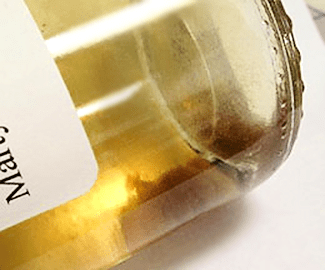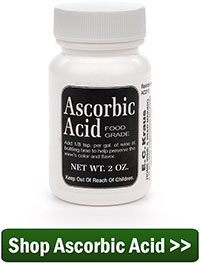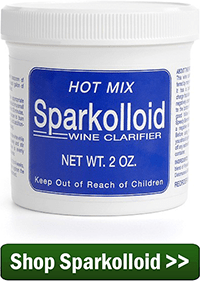 I bottled some wine in 2014-2015 when I first started wine making. Back then I skipped too many step. Well the wine taste good but some of the batches have sediment. Though this does not bother me when you are sharing it bothers some. My question is can I filter and re-bottle homemade wine. I thought it might be that easy. If so, I would have a short bottle of wine after filtering that I would get to drink. 🙂 The picture is some Pumpkin wine I made that still has Pumpkin fibers in it.
I bottled some wine in 2014-2015 when I first started wine making. Back then I skipped too many step. Well the wine taste good but some of the batches have sediment. Though this does not bother me when you are sharing it bothers some. My question is can I filter and re-bottle homemade wine. I thought it might be that easy. If so, I would have a short bottle of wine after filtering that I would get to drink. 🙂 The picture is some Pumpkin wine I made that still has Pumpkin fibers in it.
Name: Marty
State: IL
—–
Hello Marty,
Yes, you can re-bottle wine, even at this late date, but you will need to be concerned with keeping air exposure to a minimum. Excessive air can cause your wine to oxidize. Oxidation will cause the wine to become darker and more brown in color. It will also cause the wine to be less fruity or more lifeless in character.
With that said, here’s the direction on how to re-bottle wine.
Getting the wine out of the bottle is where most of the oxygen exposure will occur. This is due to the glugging of the wine as it is being poured. This is the step where you will want to take care, and keep the glugging of the wine to minimum.
Fortunately, there are a couple of things you can do to counter the potential effects of oxidation when re-bottling wine:
- First is to treat the wine with sulfites after it has been put into a common container. This would either be Campden tablets, potassium metabisulfite or sodium metabisulfite. Any of these will work. This will drive out most of the oxygen that was saturated into the wine during decanting.

- Secondly, you can add a dose of ascorbic acid to the wine. This will help to lower the pH of the wine without affecting its flavor. Lower pH means oxygen will have a harder time oxidizing the phenolic compounds in the wine.
A carboy would be the ideal container in which to clear the wine when it is being re-bottled. This will allow you to eliminate any excessive airspace in with the wine due to the shape of the carboy’s neck. Keeping the airspace down to a minimum is important because it will take the wine several days, if not a couple weeks, to clear.
Filtering the wine is not a good option in this situation. Judging from the picture you provided, the wine is clear; it just needs to taken away from the solids collecting in the wine.
To help speed up the process and get the wine re-bottled, I would recommend using a fining agent or wine clarifier on the wine. Because this is a pumpkin wine, which is light in color and may have an abundance of protein in it, I would suggest using Sparkolloid as the choice for a fining agent. Sparkolloid will easily drop out the protein, or fiber as you called it. It is also helpful in stripping some of the browning affects of oxidation from a wine. This is an added bonus. Just follow the directions on the jar to treat the wine.
Once the wine has been treated and cleared you can then re-bottle the wine. Re-bottling this time will be no different than any other time. You will want to add sulfites, again, just before doing so, as most of the sulfite added earlier will have dissipated from the wine.
Many home winemakers have ask, “can I re-bottle homemade wine”, for a number of different reasons: from making the wine sweeter to, “I don’t like the color of the wine bottle”. Hopefully, this information will clear up how to re-bottle wine in a safe way that will not jeopardize the wine so much.
Best Wishes,
Ed Kraus
—–
Ed Kraus is a 3rd generation home brewer/winemaker and has been an owner of E. C. Kraus since 1999. He has been helping individuals make better wine and beer for over 25 years.

When reading the label on a bottle of wine when describing the wine it states that it has an Apple with a touch of Lemon taste or what ever. Dose that mean it has been added to the wine ? or the grape used brings out that flavor.
Daniel, when a description of a wine refers to a: "hint of peach" or "note of rich berries", they are not saying that these fruits were used to make the wine. They are saying that the wine has flavors that are reminiscent of these fruits. They are comparisons that are being used to help described the wines flavor.
I back-sweeten my wines with a good flavored honey to make a mead. The fine matter in the honey will settle out in the bottom of the mead. I take a clean wine bottle and place a cotton ball in a funnel. Filtering the mead through the cotton ball removes all the fine material and leaves a clear sparkling bottle of mead.
I just did this recently with some 3-year old apple wine. It was from my beginning days of wine making and it wasn’t very good which is why there was so much left. I had added apple pie spice and ended up with spice and apple sediment in all the bottles. I used a tube to siphon from 750 ml bottles into a 4 L jug, leaving all the sediment in the smaller bottles. It kept the aeration to a minimum and I stopped before it started picking up sediment.
I bottled some Moscato in Oct 2018 into 1.5l bottles. I would love to re rack this into 750ml bottles. Is it too late to just transfer the wine? Thanks
Tim, yes, you can re-bottle your wine, even at this late date, but you will need to be concerned with keeping air exposure to a minimum. Excessive air can cause your wine to oxidize. The article posted below will discuss this in more detail.
Ca I Re-bottle My Wine
https://blog.eckraus.com/can-i-re-bottle-wine-how-to
when doing the re bottle procedure mentioned above,is it necessary to use potassium sorbate a second time ?
Brian, As long as you do not filter the wine, you do not need to add any additional potassium sorbate.